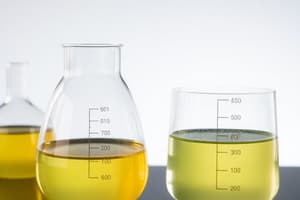Podcast
Questions and Answers
What is the pH of a solution containing 0.10 mole of ephedrine and 0.01 mole of ephedrine hydrochloride, given that the pKb of ephedrine is 4.64?
What is the pH of a solution containing 0.10 mole of ephedrine and 0.01 mole of ephedrine hydrochloride, given that the pKb of ephedrine is 4.64?
- 11.00
- 9.38
- 8.00
- 10.36 (correct)
Which statement best describes the buffer capacity (β) of a solution?
Which statement best describes the buffer capacity (β) of a solution?
- It prevents all pH changes in a solution.
- It is a measure of the volume of solution required to buffer pH changes.
- It indicates the grams of strong acid/base needed to change pH by one unit. (correct)
- It reduces the concentration of strong acids.
When does a buffer solution have maximum buffer capacity (β max)?
When does a buffer solution have maximum buffer capacity (β max)?
- When the pH is greater than the pKa value.
- When the pH is equal to the pKb of the weak acid.
- When the pH equals the pKa of the weak acid. (correct)
- When there is a low concentration of the salt.
What does Van Slyke's equation calculate in relation to a buffer solution?
What does Van Slyke's equation calculate in relation to a buffer solution?
In the context of buffer solutions, what is indicated by the term 'C' in maximum buffer capacity equations?
In the context of buffer solutions, what is indicated by the term 'C' in maximum buffer capacity equations?
What is the primary characteristic of a buffer solution?
What is the primary characteristic of a buffer solution?
Which equation is used to calculate buffer capacity?
Which equation is used to calculate buffer capacity?
In the reaction where CH3COO− ions neutralize H+ ions, what product is formed?
In the reaction where CH3COO− ions neutralize H+ ions, what product is formed?
What does a hypotonic solution do when introduced to a cell?
What does a hypotonic solution do when introduced to a cell?
How does a weak base buffer maintain pH when a strong acid is added?
How does a weak base buffer maintain pH when a strong acid is added?
What happens when a strong acid is added to a buffer mixture containing NH4OH?
What happens when a strong acid is added to a buffer mixture containing NH4OH?
Which equation represents the buffer equation for a weak acid and its salt?
Which equation represents the buffer equation for a weak acid and its salt?
When the pH of a medium is equal to the pKa of the acid, what is the state of the drug?
When the pH of a medium is equal to the pKa of the acid, what is the state of the drug?
What is the molar ratio of salt to acid required to prepare an acetate buffer of pH 5.0 given the pKa of acetic acid is 4.76?
What is the molar ratio of salt to acid required to prepare an acetate buffer of pH 5.0 given the pKa of acetic acid is 4.76?
Why are buffer solutions not commonly made from weak bases and their salts?
Why are buffer solutions not commonly made from weak bases and their salts?
Flashcards
Buffer solutions
Buffer solutions
Solutions that resist pH changes when small amounts of acid or base are added. Typically consist of a weak acid and its salt or a weak base and its salt.
Buffer action
Buffer action
The ability of a buffer solution to resist changes in pH upon addition of acid or base.
How a buffer works
How a buffer works
A strong acid or base added to a buffer is neutralized by the weak acid or base component of the buffer, minimizing pH change.
Buffer capacity
Buffer capacity
Signup and view all the flashcards
Buffers in biological systems
Buffers in biological systems
Signup and view all the flashcards
pKa
pKa
Signup and view all the flashcards
Buffer Equation (Henderson-Hasselbalch)
Buffer Equation (Henderson-Hasselbalch)
Signup and view all the flashcards
Weak Base Buffer
Weak Base Buffer
Signup and view all the flashcards
Buffer Equation for Weak Bases
Buffer Equation for Weak Bases
Signup and view all the flashcards
Maximum Buffer Capacity
Maximum Buffer Capacity
Signup and view all the flashcards
Maximum Buffer Capacity (β max)
Maximum Buffer Capacity (β max)
Signup and view all the flashcards
Buffer Capacity (β)
Buffer Capacity (β)
Signup and view all the flashcards
Study Notes
Buffers
- Buffers are solutions resisting pH changes when acids or bases are added.
- Typically, a buffer solution consists of a weak acid and a salt of that acid or a weak base and a salt of that base.
- Buffer action is the solution's ability to resist pH changes.
Buffer Action Examples
- A sodium chloride solution is not a buffer because adding acid or base significantly alters pH.
- A weak acid (acetic acid) mixed with its salt (sodium acetate) forms a buffer. If a strong acid is added, the H+ ions are neutralized by the acetate ions, changing pH minimally.
- A weak base (ammonium hydroxide) mixed with its salt (ammonium chloride) forms a buffer. If a strong acid is added, the H+ ions are neutralized by the base, with minimal pH change. If a strong base is added, OH- ions are neutralized by the ammonium ions.
The Buffer Equation
- The pH of a buffer solution and the pH change due to adding acid or base can be calculated using a buffer equation.
- The equation considers the effect of a salt on the ionization of a weak acid or base if they share a common ion.
- For a weak acid and its salt: pH = pKa + log ([salt]/[acid])
- For a weak base and its salt: pH = pKw - pKb + log ([base]/[salt])
Buffer Capacity
- Buffer capacity (β) measures a buffer's resistance to pH change.
- A higher capacity means more acid/base is needed to change pH.
- The capacity is related to the amount of strong acid/base needed to shift pH by one unit in a liter of buffer solution.
- Van Slyke's equation calculates buffer capacity: β = 2.303C (Ka[H3O+]) / (Ka + [H3O+])²
Maximum Buffer Capacity
- Maximum buffer capacity (βmax) occurs when pH equals the pKa.
- βmax = 0.576C, where C is the total buffer concentration.
Buffer Capacity Factors
- Buffer capacity depends on the ratio of salt to acid/base, and total buffer concentration.
- Optimal buffer ratio is 1:1 (salt:acid or base).
- Higher total concentration results in greater buffer capacity (more acid/base needed to change pH).
Buffers in Biological Systems
- Blood pH is maintained around 7.4 by primary and secondary buffers.
- Plasma contains carbonic acid/bicarbonate and protein buffers.
- Erythrocytes contain hemoglobin/oxyhemoglobin and phosphate buffers.
- Experimentally, whole blood has a buffer capacity of about 0.039 gram equivalents per liter/pH unit, with most from cells.
- pH outside of 7.0-7.8 is a danger sign.
Pharmaceutical Buffers
- Sorensen proposed using sodium phosphate salts to create pH 6-8 buffers, made isotonic using sodium chloride.
- Hind-Goyan used boric acid, sodium borate, and sodium chloride for pH 7-9 ophthalmic solutions.
Preparation of Pharmaceutical Buffers
- Choose an optimal pH.
- Select a weak acid or base with a pKa near the desired pH and is nontoxic, physically/chemically compatible with other additives.
- Calculate the salt/acid/base ratio using the buffer equation.
- Determine the total buffer concentration needed for the desired capacity using Van Slyke's equation. (0.05M is often enough; 0.01-0.1 sufficient)
Buffer Capacity Impact on Tissue Irritation
- Solutions for tissues/parenteral use are prone to irritation if their pH or buffer capacity is incompatible with the relevant body fluid's pH or capacity.
- Lower buffer capacity, less volume in contact with the body fluid, or larger buffer capacity of the contacted body fluid all contribute to reduced irritation risk.
Drug Stability
- Aqueous drug instability can arise from the catalytic effect of acids or bases.
- Cocaine decomposition minimizes around pH 2-5.
- Thiamine HCl is unstable above a pH of 5.
Drug Activity
- Drugs like mandelic acid, benzoic acid, and salicylic acid are more effective as antibacterial agents in their unionized form at acidic pH.
Drug Absorption
- Ionization degree and lipoid solubility affect rate of drug absorption through cellular membranes.
- Weak organic acids/bases readily dissolve in lipids and pass through lipid-like cellular membranes in their non-ionized form.
pH and Solubility
- Ionization of weak acids/bases depends on their pKa and solution pH.
- Ionization degree influences many pharmaceutical drug properties.
- At acidic (low) pH, bases exist mostly in ionic form, tending to increase solubility in aqueous solutions.
Studying That Suits You
Use AI to generate personalized quizzes and flashcards to suit your learning preferences.




